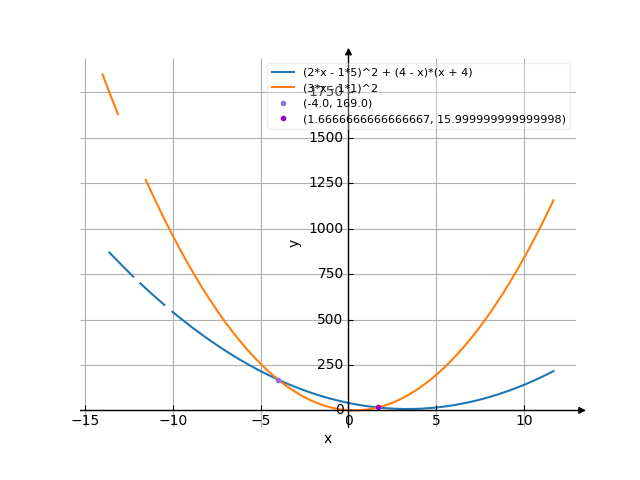(2x-5)^2+(4-x)(x+4)=(3x-1)^2 equation
The teacher will be very surprised to see your correct solution 😉
The solution
You have entered
[src]
2 2 (2*x - 5) + (4 - x)*(x + 4) = (3*x - 1)
$$\left(4 - x\right) \left(x + 4\right) + \left(2 x - 5\right)^{2} = \left(3 x - 1\right)^{2}$$
Detail solution
Move right part of the equation to
left part with negative sign.
The equation is transformed from
$$\left(4 - x\right) \left(x + 4\right) + \left(2 x - 5\right)^{2} = \left(3 x - 1\right)^{2}$$
to
$$- \left(3 x - 1\right)^{2} + \left(\left(4 - x\right) \left(x + 4\right) + \left(2 x - 5\right)^{2}\right) = 0$$
Expand the expression in the equation
$$- \left(3 x - 1\right)^{2} + \left(\left(4 - x\right) \left(x + 4\right) + \left(2 x - 5\right)^{2}\right) = 0$$
We get the quadratic equation
$$- 6 x^{2} - 14 x + 40 = 0$$
This equation is of the form
A quadratic equation can be solved
using the discriminant.
The roots of the quadratic equation:
$$x_{1} = \frac{\sqrt{D} - b}{2 a}$$
$$x_{2} = \frac{- \sqrt{D} - b}{2 a}$$
where D = b^2 - 4*a*c - it is the discriminant.
Because
$$a = -6$$
$$b = -14$$
$$c = 40$$
, then
Because D > 0, then the equation has two roots.
or
$$x_{1} = -4$$
Simplify
$$x_{2} = \frac{5}{3}$$
Simplify
left part with negative sign.
The equation is transformed from
$$\left(4 - x\right) \left(x + 4\right) + \left(2 x - 5\right)^{2} = \left(3 x - 1\right)^{2}$$
to
$$- \left(3 x - 1\right)^{2} + \left(\left(4 - x\right) \left(x + 4\right) + \left(2 x - 5\right)^{2}\right) = 0$$
Expand the expression in the equation
$$- \left(3 x - 1\right)^{2} + \left(\left(4 - x\right) \left(x + 4\right) + \left(2 x - 5\right)^{2}\right) = 0$$
We get the quadratic equation
$$- 6 x^{2} - 14 x + 40 = 0$$
This equation is of the form
a*x^2 + b*x + c = 0
A quadratic equation can be solved
using the discriminant.
The roots of the quadratic equation:
$$x_{1} = \frac{\sqrt{D} - b}{2 a}$$
$$x_{2} = \frac{- \sqrt{D} - b}{2 a}$$
where D = b^2 - 4*a*c - it is the discriminant.
Because
$$a = -6$$
$$b = -14$$
$$c = 40$$
, then
D = b^2 - 4 * a * c =
(-14)^2 - 4 * (-6) * (40) = 1156
Because D > 0, then the equation has two roots.
x1 = (-b + sqrt(D)) / (2*a)
x2 = (-b - sqrt(D)) / (2*a)
or
$$x_{1} = -4$$
Simplify
$$x_{2} = \frac{5}{3}$$
Simplify
Sum and product of roots
[src]
sum
0 - 4 + 5/3
$$\left(-4 + 0\right) + \frac{5}{3}$$
=
-7/3
$$- \frac{7}{3}$$
product
1*-4*5/3
$$1 \left(-4\right) \frac{5}{3}$$
=
-20/3
$$- \frac{20}{3}$$
-20/3
The graph


![Solve the equation (2x-5)²+(4-x)(x+4)=(3x-1)² ((2x minus 5) squared plus (4 minus x)(x plus 4) equally (3x minus 1) squared) - Find the roots of the equation in detail step by step. [THERE'S THE ANSWER!] (2x-5)^2+(4-x)(x+4)=(3x-1)^2](/media/krcore-image-pods/176/hash/equation/c/a2/71c591f52f87e560a69b5553e2bdd.png)
 Equation (x-2)^2=(x-9)^2
Equation (x-2)^2=(x-9)^2
 Equation x+2/x=3
Equation x+2/x=3
 Equation 3*9^(x-1/2)-7*6^x+3*4^(x+1)=0
Equation 3*9^(x-1/2)-7*6^x+3*4^(x+1)=0
 Equation √(x^2-1)^3=2*x
Equation √(x^2-1)^3=2*x
 (3x-1)^2
(3x-1)^2
 (3x-1)^2
(3x-1)^2